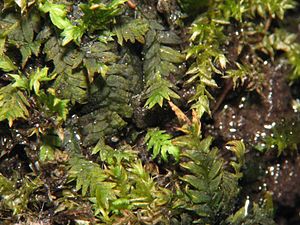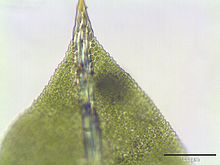Yew-leaved split tooth moss
| Yew-leaved split tooth moss | ||||||||||||
|---|---|---|---|---|---|---|---|---|---|---|---|---|

Yew-leaved split tooth moss ( Fissidens taxifolius ) |
||||||||||||
| Systematics | ||||||||||||
|
||||||||||||
| Scientific name | ||||||||||||
| Fissidens taxifolius | ||||||||||||
| Hedw. |
The yew-leaved split tooth moss ( Fissidens taxifolius ) is a deciduous moss that also occurs in Central Europe and grows in mostly dense stands that are fresh green to dark green in color.
Identifying features
The typically two-line leafy shoots are no longer than 2 cm and often branched at the base. The tongue-shaped to elongated lanceolate leaves are pointed, have no border on the leaf edge (in contrast to other Fissidens species) and have a rib that emerges briefly as a spike tip . At the base of the leaf there is a leaf sheath that is longer than the above blade part. It can be understood as a two-layer lamina. The lamina cells are rounded, hexagonal and about 8 to 12 µm in diameter. The reddish, about 15 mm long seta arises at the base of the rung. The elongated egg-shaped, ellipsoidal to asymmetrical shaped spore capsules are formed in winter.
Occurrence
The extremely pioneering Fissidens taxifolius colonizes open, lime-rich or base-rich, weakly basic to weakly acidic, loamy, sandy-loamy, clayey, often low-humus soil and occurs in open, shady to moderately light, fresh to moist areas. It prefers open-ground, disturbed forest locations, but can also be found on embankments, the edges of water, on dead wood, in gaps in meadows and pastures, in fallow fields and at the edges of ditches. More rarely, it also colonizes limestone or rocky sites. Characteristic companion mosses are Brachythecium velutinum , Eurhynchium hians , Eurhynchium praelongum and also Physcomitrium pyriforme at defects . The moss is mainly widespread in Central Europe, but is otherwise circumpolar.
literature
- Jan-Peter Frahm , Wolfgang Frey : Moosflora (= UTB . 1250). 4th, revised and expanded edition. Ulmer, Stuttgart 2004, ISBN 3-8252-1250-5 , p. 106.
- Martin Nebel, Georg Philippi (ed.): The mosses of Baden-Württemberg. Volume 1: General part, special part (Bryophytina I, Andreaeales to Funariales). Ulmer, Stuttgart 2000, ISBN 3-8001-3527-2 .
- Volkmar Wirth , Ruprecht Düll : Color Atlas of Lichen and Moss. Ulmer, Stuttgart (Hohenheim) 2000, ISBN 3-8001-3517-5 .

